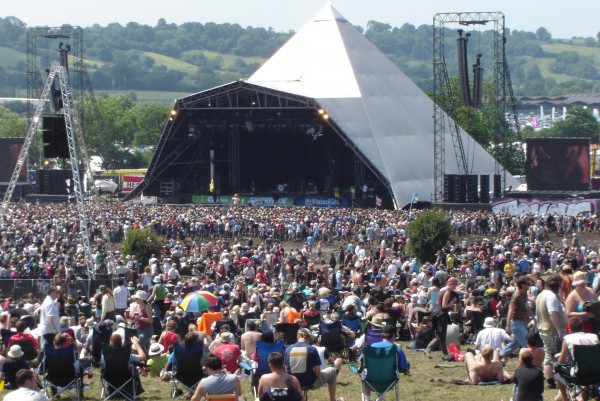 An annual event takes place every October that leads to a large number of frustrated consumers – the sale of tickets for the Glastonbury festival. This year the sale of standard tickets began at 9.00am on Sunday 5th October. Within 27 minutes all of the 120,000 tickets had been sold and it was reported that over a million people had tried to access the website. Social media was full of messages from disappointed fans that had been unable to get a ticket.
An annual event takes place every October that leads to a large number of frustrated consumers – the sale of tickets for the Glastonbury festival. This year the sale of standard tickets began at 9.00am on Sunday 5th October. Within 27 minutes all of the 120,000 tickets had been sold and it was reported that over a million people had tried to access the website. Social media was full of messages from disappointed fans that had been unable to get a ticket.
The Glastonbury festival has grown in popularity and the organisers adopted a unique way of selling the tickets a number of years ago. They introduced a system that made it impossible for people to purchase tickets unless they had previously registered. Although there is no charge to register, in order to complete the process successfully, people have to submit a clear passport style photograph in Jpeg format. Once registered, customers are allocated a unique registration number which they must submit in order to purchase a ticket when they go on sale. Each buyer can purchase up to a maximum of 6 tickets and must provide a valid registration number for each separate ticket they obtain. Successful applicants receive a personalised ticket, including their photo, which cannot be re-sold. The organisers have been very clear about the rationale for introducing this scheme. They have stated that it is part of their
“on-going efforts to cut out ticket touting”
However a number of people have criticised the ticket sale process. These criticisms tend to fall into two key areas: first, the method used in the initial sale process and second, the constraints placed on resale after a ticket has been purchased.
The tickets are sold by the company SeeTickets and their Head of Business Development stated in an interview in 2013 that:
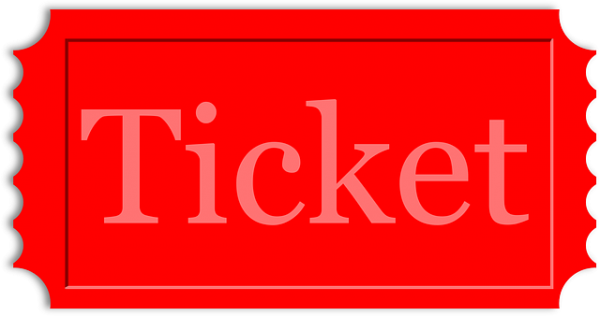 There is something like 1,100,000 customers registered to go to Glastonbury, and they all want a ticket. It’s a shame but there is nothing you can do about it. The 900,000 people that don’t get to go often come up with the argument, why don’t you just have a ballot? Why don’t we just register and a computer generated ballot just picks the winners? I think they’ve (Glastonbury) always had a view that if you get a ticket to Glastonbury there’s an element of work that you have to do to achieve that and it does reward that commitment. I think there’s a sense that if you use a ballot then maybe you’d get some people who were not as committed.
There is something like 1,100,000 customers registered to go to Glastonbury, and they all want a ticket. It’s a shame but there is nothing you can do about it. The 900,000 people that don’t get to go often come up with the argument, why don’t you just have a ballot? Why don’t we just register and a computer generated ballot just picks the winners? I think they’ve (Glastonbury) always had a view that if you get a ticket to Glastonbury there’s an element of work that you have to do to achieve that and it does reward that commitment. I think there’s a sense that if you use a ballot then maybe you’d get some people who were not as committed.
However responding to these comments a customer commented that:
I’ve been lucky in the past and got tickets within minutes and like this year tried all morning and come away empty handed. Whether I have been successful has nothing to do with hard work but the vagaries of the internet and a bit of luck.
Another customer commented:
No ballot! It’s too random. People who really,really want to go should get the tickets, so the only fair way is regional ticket sales, where you could queue ( overnight if required) to get your ticket. This is the only fair way. Year after year genuine fans miss out. This way fans who are willing to make an effort get the chance, rather than a ballot or the random computer system which they have at present.
Others have criticised the limited ability consumers are given to resell their tickets. The full cost of a ticket for the 2015 festival is £220 plus a £5 booking fee. When the tickets are originally sold in October, the buyers have to pay a £50 deposit and at this point none of the bands playing at the festival have been announced. The remaining balance of £175 is due at the beginning of April by which point some of the bands/acts will have been confirmed. Anyone who decides not to pay the balance or cancel their order before this date is refunded their deposit, minus an administration fee. Those tickets are then put forward for re-sale. The re-sale process typically takes place at the end of April and once again is only open to people who have previously registered. Last year 10,000 tickets were re-sold in just 12 minutes! Once this period in April is over the re-sale of tickets is prohibited even though the complete line-up for the festival may not have been confirmed.
The secondary ticket company Viagogo reported the results from research they had carried out on the 2014 festival. This found that following the relatively late announcement of Metallica as one of the headline acts,78% of people who had bought a ticket said they would have resold it if they’d had the chance.
A spokesperson from Viagogo stated that:
We believe that once you’ve bought a ticket it’s yours and if you want to sell it or give it away, you should be allowed to do so. In this case, with an unpopular headline act announced late, ticket holders lose out because they can’t resell their tickets and Metallica fans lose out because they can’t buy them.
Those people who either did not get a ticket or are left with a ticket they would rather re-sell will no doubt continue to complain about the ticket selling process.
The economics of GlastonburyThe Economist (24/6/14)
Handbag Economics: How much Glastonbury will really cost you Handbag Economics (12/6/14)
Should Glastonbury Festival tickets go to the ballot? Virtual Festivals (8/10/13)
Glastonbury 2014: Four in five fans wanted to resell tickets after Metallica announcement The Independent (26/6/14)
Third of Glasto fans put-off by strict ‘no ticket resale policy’ – but 2015 is still a sell-out The Mirror (6/10/14)
“People wanted to sell Glastonbury tickets!” says ticketing website Bad PR (3/7/14)
The pain of Glastonbury tickets – in two charts The Mirror (6/10/14)
Questions
- What is the opportunity cost of going to the Glastonbury Festival? Discuss some of the non-ticket factors you have included in your calculations.
- Draw a demand and supply diagram to illustrate the market for Glastonbury tickets. NB think carefully about the shape of the supply curve in both the short-run and the long run. Is the current price of a ticket at the market clearing level? Explain your answer.
- The sale and re-sale of tickets takes place before the all the headline acts have been announced. Illustrate what will happen to the demand curve for consumers with different preferences once the headline acts have been announced.
- Assess the relative costs and benefits of using a ballot instead of the current system used by the festival organisers to sell of tickets.
- The organisers of the festival introduced the registration process in order to limit the re-sale of the tickets. Analyse the impact of this policy on Pareto and allocative efficiency? Will the policy cause any deadweight welfare loss? What factors will determine the size of any deadweight welfare loss?
- Suggest some reasons why care may need to be taken when using the results from the research carried out by Viagogo.
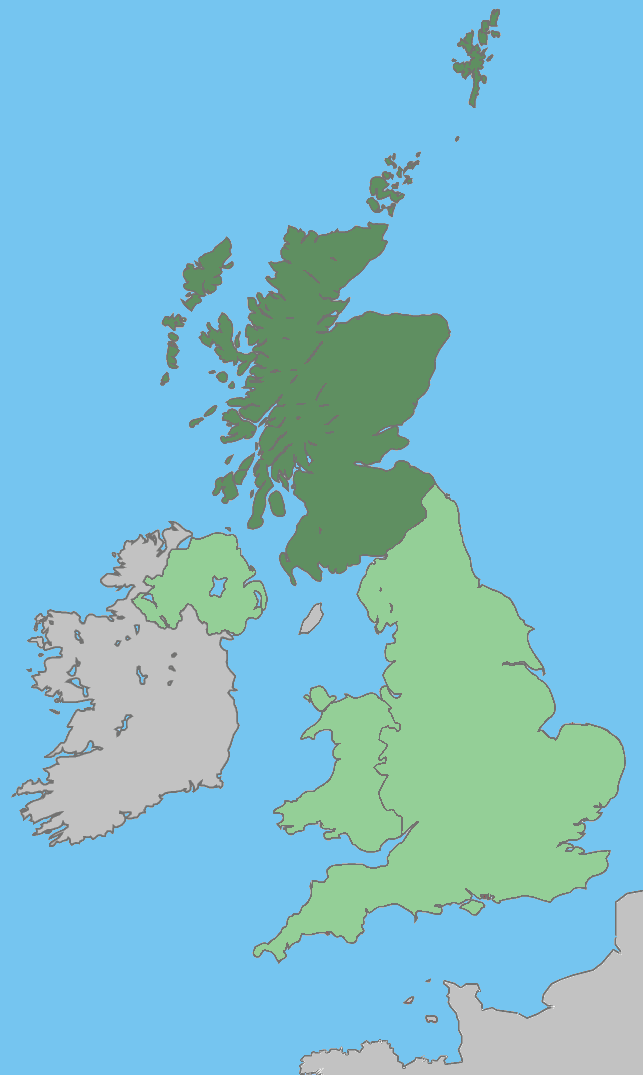 The Scottish debate revolved around a variety of issues and one of the key factors that added weight to the ‘No’ campaign was the idea of being British. But the concept of ‘Britishness’ is not just important to those who live here. It still appears to be a key signal of quality in foreign markets and it is something which foreign consumers are willing to pay a price for.
The Scottish debate revolved around a variety of issues and one of the key factors that added weight to the ‘No’ campaign was the idea of being British. But the concept of ‘Britishness’ is not just important to those who live here. It still appears to be a key signal of quality in foreign markets and it is something which foreign consumers are willing to pay a price for.
Barclays Corporate Banking has undertaken research into eight key export markets to determine the value of ‘Britain’. One of the key factors that boost demand for a product is quality and another is the idea of a brand. As quality improves and brands become more recognized, a product’s demand curve will begin to shift to the right, thus pushing up the market price. In other words, with higher quality and brand recognition, an individual’s willingness to pay rises. One brand that foreign consumers seem willing to pay a premium to purchase are those labelled ‘Made in Britain’.
The research indicates that 31% of customers in emerging markets have been prepared to and have purchased products that are from Britain, despite the higher price. Seeing the label ‘Made in Britain’ seems to send the signal of quality and this in turn creates a higher willingness to pay. Furthermore, this willingness to pay, while still good for Scottish, English and Welsh products, is higher for ‘British’ products, perhaps another indication of the truth behind the ‘Better together’ campaign.
The increase in willingness to pay between products with seemingly no country of origin and a British country of origin is 7% and this knowledge should give a confidence boost to the British export market. It should also indicate to exporters in Wales, Scotland and England that they are better to advertise as ‘Made in Britain’ than ‘Made in Wales, Scotland or England’. The expected boost from the 8 key emerging markets is around £2bn. The following articles consider the concept of ‘Brand Britain’.
Good news for exports as Brand Britain is revealed to be valuable concept Small Business, John Bromley (3/11/14)
Britain ‘best brand’ for Welsh exports, survey suggests BBC News (26/11/11)
Overseas consumers 64% more willing to pay premium for ‘Brand Britain’ Marketing Week, Sebastian Joseph (3/11/14)
Report flags up ‘British’ benefit The Courier, James Williamson (3/10/14)
Questions
- Using a diagram, illustrate the effect of a product’s being a well-known brand on its equilibrium price and quantity.
- Why is it that the relative willingness to pay a premium for British products is higher in developing countries than in developed countries?
- Using the concept of marginal utility theory, explain the impact of the ‘Made in Britain’ label.
- The BBC News article suggests, however, that some Welsh companies have not found the brand effect to be the case. What factors might explain this?
- To what extent are the concepts of consumer and producer surplus relevant here?
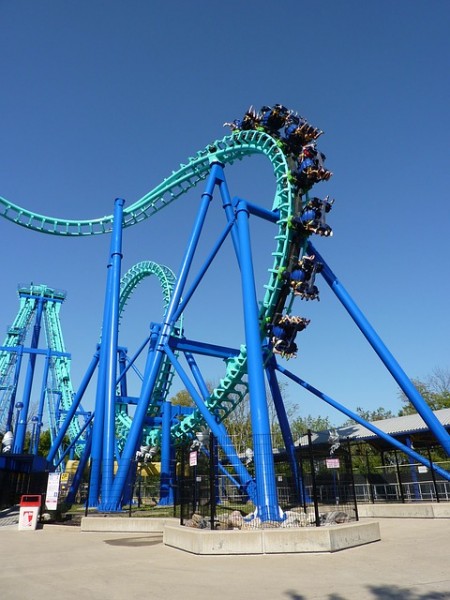 Merlin Entertainments PLC is one of the largest operator of visitor attractions in the world and owns over a third of the most popular theme parks in Europe. It runs the four most visited parks in England – Alton Towers, Legoland Windsor, Thorpe Park and Chessington World of Adventures as well as the most popular theme park in Italy – Gardaland. Alton Towers alone had 2.5 million visitors in 2013. Anybody thinking of going to one of these attractions is faced with a wide range of different entry fees .
Merlin Entertainments PLC is one of the largest operator of visitor attractions in the world and owns over a third of the most popular theme parks in Europe. It runs the four most visited parks in England – Alton Towers, Legoland Windsor, Thorpe Park and Chessington World of Adventures as well as the most popular theme park in Italy – Gardaland. Alton Towers alone had 2.5 million visitors in 2013. Anybody thinking of going to one of these attractions is faced with a wide range of different entry fees .
Theme parks and tourist attractions have market power so their owners have to make some interesting pricing decisions. They have to tackle the same dilemma that confronts any seller that faces a downward sloping demand curve for its goods/services.
One option for the firm would be to increase the entry fee. This would produce higher profits per visitor as some of the surplus from the transaction previously enjoyed by the consumer will be extracted by the seller and converted into producer surplus. Unfortunately for the business the higher price, all other things equal, will also result in fewer visitors. Some people will be deterred from visiting because of the higher price and the seller will lose out on potential revenue.
An alternative strategy would be for the theme park to reduce its entry fee. All other things equal, this will increase the number of visitors. However, it would also mean that the profit per customer would fall. The frustrating issue for the seller is that some of its customers, who would still have visited the attraction at the higher price, are now able to get a better deal.
This dilemma exists if the seller has to charge all of its different customers the same entry fee. If it could charge a higher entry fee to those customers who would be willing to pay more and a lower entry fee to those who would be willing to pay less then it could make more money. Extra revenue could be obtained from those additional sales that take place at the lower price while more consumer surplus could be extracted from those still paying the higher price.
Is it possible for a firm to charge different prices to different customers for the same or a similar good or service? Table 1 below shows the entry fees for Warwick Castle, another tourist attraction owned by Merlin Entertainments PLC.
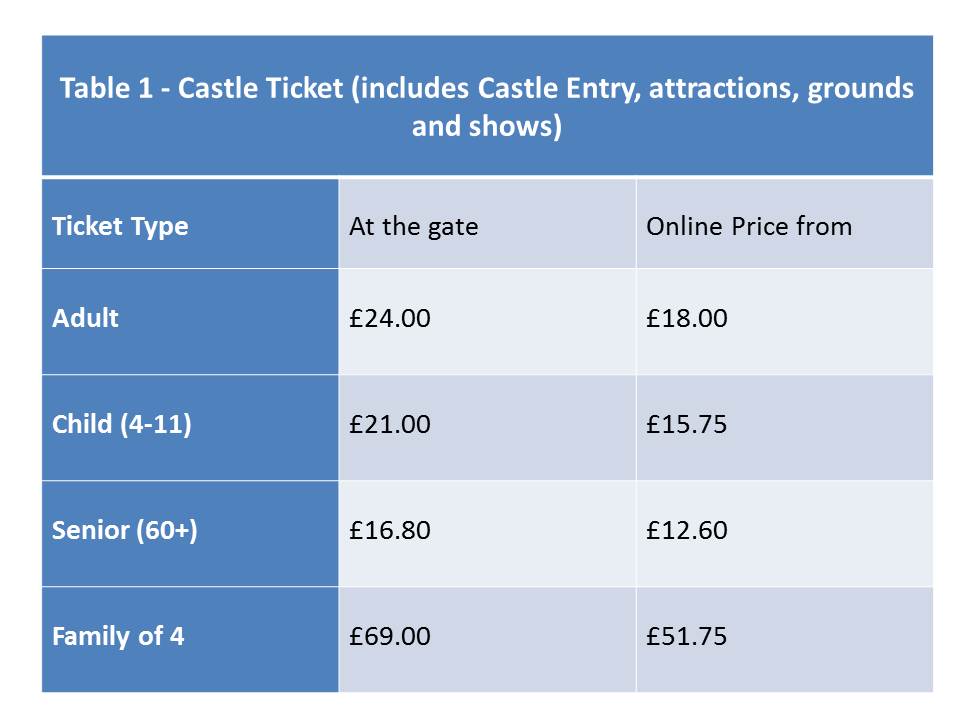
It can immediately be seen from this table that some groups of customers pay a different entry fee from others. For example adults have to pay £24 to enter on the day while people aged 60 and over pay a lower price £16.80. The entry fee for children aged between 4 and 11 is £21.00 while those aged 3 and under go for free. Students aged 16-18 can gain entry for a price of £13.50 if they can provide valid ID and purchase the tickets from the visitbritainshop website.
In this example, the company has allocated people into different categories by age (i.e. senior, adult, student, older children and younger children) and has set the entry fee that customers in each group have to pay.

The table also shows that if customers purchase on- line then they can get the tickets more cheaply. The entry fee for each category is 25% lower if the ticket is booked seven days in advance i.e. the prices shown in the last column in the table. If the booking is made between 2-6 days in advance then the discount is only 10% i.e. an adult ticket would cost £21.60. The on-line discounts are open to everyone. People are given the choice to either book on-line in advance or pay on the day. This is different from a situation where you are placed into a category by the firm. For example the customer cannot choose whether they are over 60!
If people are prepared to spend more time searching on the internet then other cheaper prices can also be obtained. Once again these offers are open to anyone willing to spend the time and effort in order to find them.
All the ticket prices above give people access to exactly the same attractions on the day. They do not give the visitor access to two of the attractions at the castle – the Dragon Tower and Castle Dungeon. Entry to the Dragon Tower would cost an adult on the day an extra £1.80 while entry to the Castle Dungeon would cost an extra £5.40.
Warwick Castle Ticket Prices Warwick Castle (accessed on 04/09/14)
Alton Towers Alton Towers (accessed on 08/09/14)
Warwick Castle Tickets visitbritainshop (accessed on 02/09/14)
Global Attractions Attendance Report teaconnect (accessed on 05/09/14)
Merlin Entertainments Merlin Entertainments (accessed on 08/09/14)
Questions
- What pricing decisions do firms have to make if they operate in a perfectly competitive market?
- Explain why an individual tourist attraction will have a downward sloping demand curve
- Paying an entry fee and an extra payment per attraction is known as what type of pricing? What advantages does this type of price strategy have for the seller?
- How would you calculate the profit per customer? What factors other than the entrance fee would determine the profit made per customer in a theme park or tourist attractions?
- Paying a different price depending on which category you have been assigned to by the seller is known as what type of pricing strategy? Can this type of pricing strategy ever be in the interests of society?
- In the example used in the case, customers are assigned to different categories by age. Can you think of any other ways that firms could categorise their customers?
- Given the category customers have been assigned to they can pay different prices depending on whether they buy the tickets on line. What is the price strategy called when customers can choose from a variety of pricing options for the same or similar product? Can you think of any different methods that could be used by the seller to carry out this type of pricing strategy?
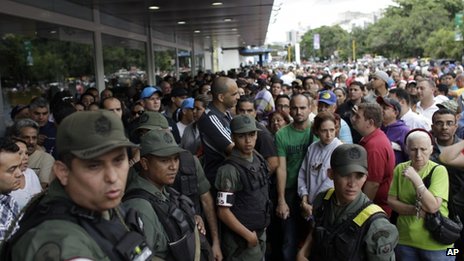 A remarkable event took place in Venezuela on Friday 8th November. Soldiers, on the orders of the president, temporarily occupied a chain of shops run by a leading electrical retailer called Dakar. The shops were forced to cut the prices of their electrical appliances and five managers were arrested and accused of ‘hiking up’ prices.
A remarkable event took place in Venezuela on Friday 8th November. Soldiers, on the orders of the president, temporarily occupied a chain of shops run by a leading electrical retailer called Dakar. The shops were forced to cut the prices of their electrical appliances and five managers were arrested and accused of ‘hiking up’ prices.
Unsurprisingly, news of these lower prices spread very quickly and long queues rapidly appeared outside the stores as people hoped to buy plasma televisions, fridges and washing machines at bargain prices. On Sunday 9th November, the president, Nicolas Maduro, gave a televised address in which he condemned the owners of the stores and announced that he was going to ask the National Assembly to grant him extra powers so that he could extend price controls to all consumer goods. He stated that he would next turn his attention to stores selling toys, cars, textiles and shoes.
The use of price controls in Venezuela is not new and dates back to 2003 when they were first introduced by the then president Hugo Chavez. Initially the regulations were imposed on various foods and basic goods. For example, by 2009 maximum prices had been set for cooking oil, white rice, sugar, coffee, flour, margarine, pasta and cheese. Businesses often complained that the maximum prices set by the government were below the costs of production. For example after a maximum price of 2.15 Bolivares was placed on a kilo of rice, producers argued that the cost of producing a kilo of rice was 4.41 Bolivares.
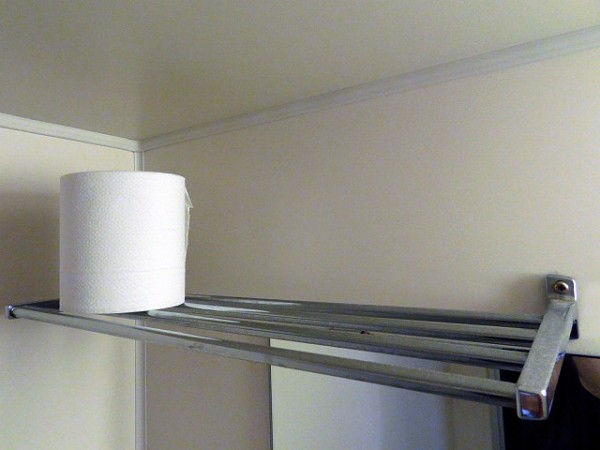 The impact of the maximum prices in Venezuela appears to have been exactly what the theories in the economics textbooks would have predicted – shortages, long queues of people waiting outside shops and a flourishing black market. An article on the shortage of toilet rolls has been discussed in a previous article on this news site: Shortages in Venezuela- what’s the solution? However this has not stopped the Venezuelan government extending the scheme and increasing the number of products that have maximum prices imposed on them. In 2011 Hugo Chavez argued that the policy was required because:
The impact of the maximum prices in Venezuela appears to have been exactly what the theories in the economics textbooks would have predicted – shortages, long queues of people waiting outside shops and a flourishing black market. An article on the shortage of toilet rolls has been discussed in a previous article on this news site: Shortages in Venezuela- what’s the solution? However this has not stopped the Venezuelan government extending the scheme and increasing the number of products that have maximum prices imposed on them. In 2011 Hugo Chavez argued that the policy was required because:
The market has…become a perverse mechanism where big monopolies, the big trans-nationals and the bourgeoise dominate and ransack the people.
Economics textbooks often include some analysis of the impact of price ceilings on a competitive market. The effects on consumer surplus, producer surplus and deadweight welfare are usually discussed. However the potential administrative costs are rarely considered. The Venezuelan case helps to illustrate how in practise these costs could be quite significant.
For example, in April 2012 price controls in Venezuela were extended to a range of 19 products including fruit juice, toilet paper, nappies, soap, detergent, deodorant, toothpaste, baby food, floor polish, mineral water and razor blades. This caused a reduction in prices of between 4% and 25%. However this did not simply mean setting 19 different maximum prices because the goods were all sold in different quantities or different package sizes. For example a tube of toothpaste could be purchased in 4 different sizes – 50ml, 75ml, 100ml and 150 ml. Therefore officials had to set 4 different figures. Nappies were sold in 12 different package sizes ranging from10 nappies/packet to78 nappies/packet. Once again this meant that the administrators had to set 10 different maximum prices just for nappies. In total across the 19 products government officials had to set prices for 616 different individual items!! Companies were given just one month to adjust to the new legislation.
Whenever maximum prices are imposed on a competitive market both frustrated buyers and sellers have an incentive to evade them and trade illegally. Therefore the government established a number of organisations in an attempt to make sure the prices were enforced. One agency is called The National Superintendency of Fair Costs and Prices or Sundecop. Officials from this agency were sent out to 82 retail outlets in April 2012 to try to make sure that firms were sticking to the new regulated prices. They also printed and handed out leaflets to the public informing them of the changes. Another agency is called ‘The Institute for the Defense of People’s Access to Goods and Services’ or ‘Indepabis’. This organisation launched a new strategy in June 2012 in order to monitor compliance. This included the creation of a network called the Friends of Indepabis which would act as an information point for members of the public to report illegal pricing. A new complaints phone line was also introduced.
If president Maduro is granted the power to extend maximum prices to all consumer products, then one can only begin to imagine the extra administrative costs involved with implementing the policy.
Venezuelan president Maduro ‘to expand price controls’ BBC News (11/11/13)
Venezuela sends in troops to force electronics chain to charge ‘fair’ prices NBC News (13/11/13)
Venezuela appliances crackdown spurs uncertainty ABC news (13/11/13)
Venezuela’s government seizes electronic goods shops BBC News (9/11/13)
Venezuelan government sends TROOPS into electronics chain to force them to sell goods at a “fair price” DailyMirror (10/11/13)
Shocher: Price Controls Lead to Shortages in Venezuela Free Advice, Robert Murphy (2/10/13)
Venezuelan Government Action against Overpricing Welcomed by Citizens, Manipulated by Media venezuelanalysis (12/11/13).
Questions
- Explain why a maximum price imposed on a competitive market might generate a shortage. Draw a diagram to illustrate and explain your answer.
- Are there any circumstances when a maximum price would not cause a shortage in a competitive market?
- Analyse the impact of a maximum price on consumer surplus, producer surplus and deadweight welfare loss. Assume the market is competitive and clearly state any other assumptions you have made in your analysis. Comment on the impact of the price ceiling on economic efficiency.
- Illustrate and explain what would happen to consumer surplus and deadweight welfare loss if the available goods for sale were only purchased by the consumers with the lowest willingness to pay.
- Why might a maximum price lead to a flourishing black market?
- The former president, Hugo Chavez, argued that the price regulations were required because “big monopolies… ransack the people”. Using economic theory discuss this statement. Examine the impact of a maximum price on a pure monopoly.
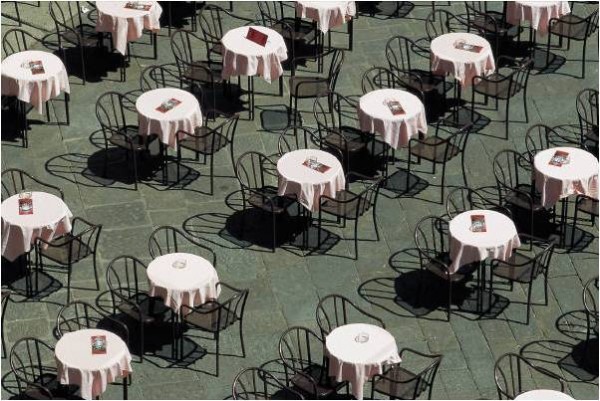 Why are 43 companies in the pub and restaurant sector in the UK donating over a £1 million to an 86 year old Frenchman who claims to work a 70 hour week? Jacques Borel has led an interesting and varied life which has included activities such as helping the French resistance in the 2nd world war and opening the first take-away hamburger restaurant in France in 1961. In 2001 he started a campaign to get the European Union to allow member states to reduce the rate of VAT applied to food and drink sold in the pub, hotel and restaurant industry. Organisations such as JD Wetherspoon, Heineken and Pizza Hut are backing his attempts to persuade the UK government of the benefits of this policy.
Why are 43 companies in the pub and restaurant sector in the UK donating over a £1 million to an 86 year old Frenchman who claims to work a 70 hour week? Jacques Borel has led an interesting and varied life which has included activities such as helping the French resistance in the 2nd world war and opening the first take-away hamburger restaurant in France in 1961. In 2001 he started a campaign to get the European Union to allow member states to reduce the rate of VAT applied to food and drink sold in the pub, hotel and restaurant industry. Organisations such as JD Wetherspoon, Heineken and Pizza Hut are backing his attempts to persuade the UK government of the benefits of this policy.
VAT is paid when goods and services are purchased and is normally included in the price advertised by the seller. It generates a significant amount of money for the UK government and it is estimated that it will raise £102 billion in 2012-13 – the third biggest source of revenue after income tax and national insurance contributions. It is applied at three different rates in the UK – a standard rate of 20%, a reduced rate of 5% and a zero rate i.e. 0%. This may sound straightforward but in reality the tax is extremely complicated as previously discussed in articles on this website . For example most basic or staple items of food sold in shops are zero rated. However there are some rather bizarre exceptions. For example a packet of potato crisps is subject to the standard rate of VAT whereas tortilla chips are not. The standard rate is applied to a packet of Wotsits whereas a zero rate is applied to a packet of Skips!
The campaign headed by Mr Borel focuses on the discrepancy between the zero-rate applied to most food items purchased from a shop and the standard rate applied to food purchased in restaurants or cafes. For example, if you buy a Pizza from a supermarket then you don’t pay any tax on this purchase, whereas if you eat a pizza in a restaurant the standard 20% rate of VAT is applied. Mr Borel is lobbying the UK government to reduce the rate of VAT paid in pubs and restaurants from the standard rate of 20% to the reduced rate of 5%. One reason why so many UK companies are willing to offer him financial support is because of his success in getting governments in other countries such as Germany, Belgium, Finland and France to adopt this policy.
In a recent radio interview Mr Borel was asked to make his case for the proposed reduction of VAT in the UK. He claimed:
I have a commitment from 125 chains of hotels, restaurants and independents to use 60% of the reduction in VAT to lower prices so that would be a 7.5% decrease in price. When you decrease price by that magnitude you will see an increase in customers of 10-12% and you will be forced to hire new staff. In our best case scenario, we plan to create 670,000 jobs in three years.
When asked in another interview why the hospitality sector should be favoured more than others he replied that:
It would create more jobs in a minimal amount of time…you cannot do that with any other industry.
One obvious drawback of the policy would be the loss of revenue for the UK government. Some estimates have suggested that the loss of VAT receipts would be between £5.5 and £7.8 billion. However it has been claimed that over time the impact of the change on government finances would be zero. In response to the proposed tax cut a Treasury spokesman commented:
Any reduced rates would make a significant impact on revenue and, as a significant proportion of spending in these areas is by UK residents, any increase in activity in these areas would largely be at the expense of other consumer spending.
Webcast
 Jacques Borel: VAT cut for pubs Morning Advertiser on YouTube (18/5/11)
Jacques Borel: VAT cut for pubs Morning Advertiser on YouTube (18/5/11)
Articles
Industry VAT campaigner Jacques Borel appears on Radio Four’s Today and Radio Five Propelinfo (24/4/13)
French veteran in fight to cut pub VAT Financial Times, Christopher Thompson (5/6/12)
The fiscal impact of reduced VAT rates VAT Club Jobs (22/4/13)
Pub and restaurant groups pay 86-year-old Frenchman £1m to convince UK government to cut VAT The Mail on Sunday, Sarah Bridge (20/4/13)
French veteran seeks British jobs boost with VAT Reuters (17/1/13)
Questions
- In his radio interview Jacques Borel claims that if firms pass on 60% of the cut in VAT this would cause a 7.5% reduction in prices. Explain why this is the case. Clearly outline any assumptions you have made in the analysis
- If 60% of the reduction was passed on by firms through lower prices, what do you think would happen to the money generated from the other 40% of the reduction?
- Using a demand and supply diagram illustrate the proposed reduction in the rate of VAT on the hospitality industry. Make sure your diagram is drawn in such a way that it clearly illustrates producers passing on 60% of the tax reduction in the form of lower prices.
- Assuming that the hospitality industry was very competitive, what impact would a reduction in VAT have on consumer surplus, producer surplus and deadweight welfare loss?
- Explain any assumptions you have in your answer to question 3 about the price elasticity of demand and supply.
- Using the figures provided in the radio interview is it possible to calculate the price elasticity of demand. Try making the calculation and clearly explain any assumptions you have made.
- Explain why the reduction in VAT might have no net effect on government finances in the long run?
- What factors determine the price elasticity of supply? What assumption is Mr Borel making about the price elasticity of supply in the hospitality industry compared to other industries when he makes the claim that jobs would be created quickly?
- Outline some of the arguments against cutting the rate of VAT.
 An annual event takes place every October that leads to a large number of frustrated consumers – the sale of tickets for the Glastonbury festival. This year the sale of standard tickets began at 9.00am on Sunday 5th October. Within 27 minutes all of the 120,000 tickets had been sold and it was reported that over a million people had tried to access the website. Social media was full of messages from disappointed fans that had been unable to get a ticket.
An annual event takes place every October that leads to a large number of frustrated consumers – the sale of tickets for the Glastonbury festival. This year the sale of standard tickets began at 9.00am on Sunday 5th October. Within 27 minutes all of the 120,000 tickets had been sold and it was reported that over a million people had tried to access the website. Social media was full of messages from disappointed fans that had been unable to get a ticket.There is something like 1,100,000 customers registered to go to Glastonbury, and they all want a ticket. It’s a shame but there is nothing you can do about it. The 900,000 people that don’t get to go often come up with the argument, why don’t you just have a ballot? Why don’t we just register and a computer generated ballot just picks the winners? I think they’ve (Glastonbury) always had a view that if you get a ticket to Glastonbury there’s an element of work that you have to do to achieve that and it does reward that commitment. I think there’s a sense that if you use a ballot then maybe you’d get some people who were not as committed.







